


Left: Pamukkale - a balloon over the travertine terraces.
Center: Pamukkale - walking up the travertine terraces.
Right: Hierapolis roman theater at Pamukkale.
Pamukkale sounds like an exotic dance, but it’s not. It’s a Unesco site in southwestern Turkey that we visited recently.
First, how do you pronounce the name? Accent is on the MUK as in Pa-MUK-kale. Second, what does it mean? It means “cotton castle” because of the white travertine terraces found there caused by deposits of calcium carbonate coming from mineral water in the hot springs. Third, you are probably wondering if it’s worth a visit. We can say yes, it is even if the hotels and eating options there are second rate (will explain below). Fourth: when people say Pamukkale, the usually mean the travertine terraces and Hierapolis, the ancient city build at the edge of the travertine terraces. In many ways, Hierapolis is much more impressive, but it takes a little work to discover that.
Visiting this strange outpost was the last thing we did on our 18 days in Turkey. For more information, see the post 18 days in Turkey – Some Observations.
In the planning stages of the trip, finding interesting lodgings in Pamukkale was harder than in other places we stayed on the trip. We are not fussy or big spenders but even for us the choices were pretty slim. Once there eating options seemed okay, not exciting. Okay, that bit of complaining aside, the place was worth visiting.
Our Pamukkale itinerary was this:Hike stats:
Center: Pamukkale - walking up the travertine terraces.
Right: Hierapolis roman theater at Pamukkale.
Pamukkale sounds like an exotic dance, but it’s not. It’s a Unesco site in southwestern Turkey that we visited recently.
First, how do you pronounce the name? Accent is on the MUK as in Pa-MUK-kale. Second, what does it mean? It means “cotton castle” because of the white travertine terraces found there caused by deposits of calcium carbonate coming from mineral water in the hot springs. Third, you are probably wondering if it’s worth a visit. We can say yes, it is even if the hotels and eating options there are second rate (will explain below). Fourth: when people say Pamukkale, the usually mean the travertine terraces and Hierapolis, the ancient city build at the edge of the travertine terraces. In many ways, Hierapolis is much more impressive, but it takes a little work to discover that.
Visiting this strange outpost was the last thing we did on our 18 days in Turkey. For more information, see the post 18 days in Turkey – Some Observations.
In the planning stages of the trip, finding interesting lodgings in Pamukkale was harder than in other places we stayed on the trip. We are not fussy or big spenders but even for us the choices were pretty slim. Once there eating options seemed okay, not exciting. Okay, that bit of complaining aside, the place was worth visiting.
Our Pamukkale itinerary was this:
- We stayed two nights in Pamukkale.
- On the way to Pamukkale (day 1), we stopped at Aphrodisias – a bit out of the way – but one our best Turkey stops in terms of exploring ruins. There were few people, and the site was impressive.
- The next day (day 2), we spent it all (about 8 hours) visiting the Pamukkale “site”, which includes the eye-catching travertine terraces and Hierapolis, up and behind the blinding white.
- The next day (day 3), we left for Izmir airport but first stopped at the ancient city of Laodicea (just a few minutes from Pamukkale) and very much worth it too.
Here’s how we visited Pamukkale during our day there:
- Since we were staying in Pamukkale, we walked to the town entrance/lower gate (here). We took off our shoes and started walking.
- When we were there the pools maybe came up to our knees at most, and it wasn’t warm water.
- But as you can see in one photo there are other dry pools. We suspect – and there was ample evidence given all the water piping – that they redirect water around so the place changes over time.
- We walked “up” the travertine terraces. Most people don’t do this. And we did it relatively early in the day so there were few people.
- As you climb – which isn’t that hard to do or that bad for your feet – you eventually reach a point where you will likely find a lot more people. This is where most people experience the travertine terraces. At this point there is an observation deck with benches. Many visitors only venture from here a little way downhill.
- All visitors arriving in bus end up at this observation point – it seems.
- They entered from either the Pamukkale south gate (here, which is more east) or the Pamukkale north gate (here, and then take a ride down).
- After passing through a throng of people just below the observation deck, we put our shoes back on and started walking roughly north following the top of the travertine terraces and ridge of the mountain until we reached the Necropolis of Hierapolis. Pretty quickly, we were alone again. Perfect!
- From there our path through Hierapolis was a bit like a pinball: we explored what looked interesting to us and sometimes doubled back. (See image in the post with tracks.)
- Eventually, we ended up – downhill – at the theater and the ploutonion.
- We grabbed a very late lunch at a concession near the museum and then went to the museum (a little disappointing).
- We made our way to the south (again, east) gate and thought about exiting there but the walk back to town from there wasn’t that interesting along a road. We couldn’t see a trail that would work. (There is probably a bus or taxi, but we didn’t want that.)
- So, we went back to the observation deck above the travertine terraces, took off our shoes and walked back down the terraces, enjoying them a second time.
Left: Our walking tracks through Pamukkale/Hierapolis - on our day spent exploring.
Center: Hierapolis - Frontius Gate.
Center: Hierapolis - Frontius Gate.
Right: Hierapolis - Latrine near Frontius Gate.
Left: Hierapolis roman theater at Pamukkale.
Center: View back over Hierapolis from a high point with white travertine in the distance.
Left: Pamukkale - a balloon lowers into the travertine terraces.
Center: Pamukkale - a boardwalk takes you along the ridge of the travertine terraces.
Right: Pamukkale - a view of the walk from the lower entrance up and idea of dry pools.
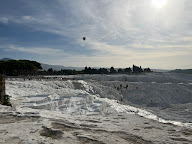
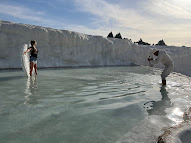
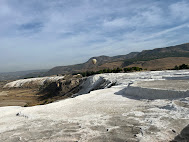
Right: Pamukkale - a view of the walk from the lower entrance up and idea of dry pools.



Left: Pamukkale - a view showing the top observation point and the crowd of people.
Center: Pamukkale - travertine terraces - lots of posing near the observation deck.
Right: Pamukkale - walking away from the crowded spots you can find other white travertine to photograph.



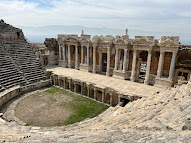



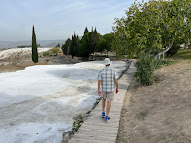

No comments:
Post a Comment
All comments are moderated. If your comment doesn't appear right away, it was likely accepted. Check back in a day if you asked a question.